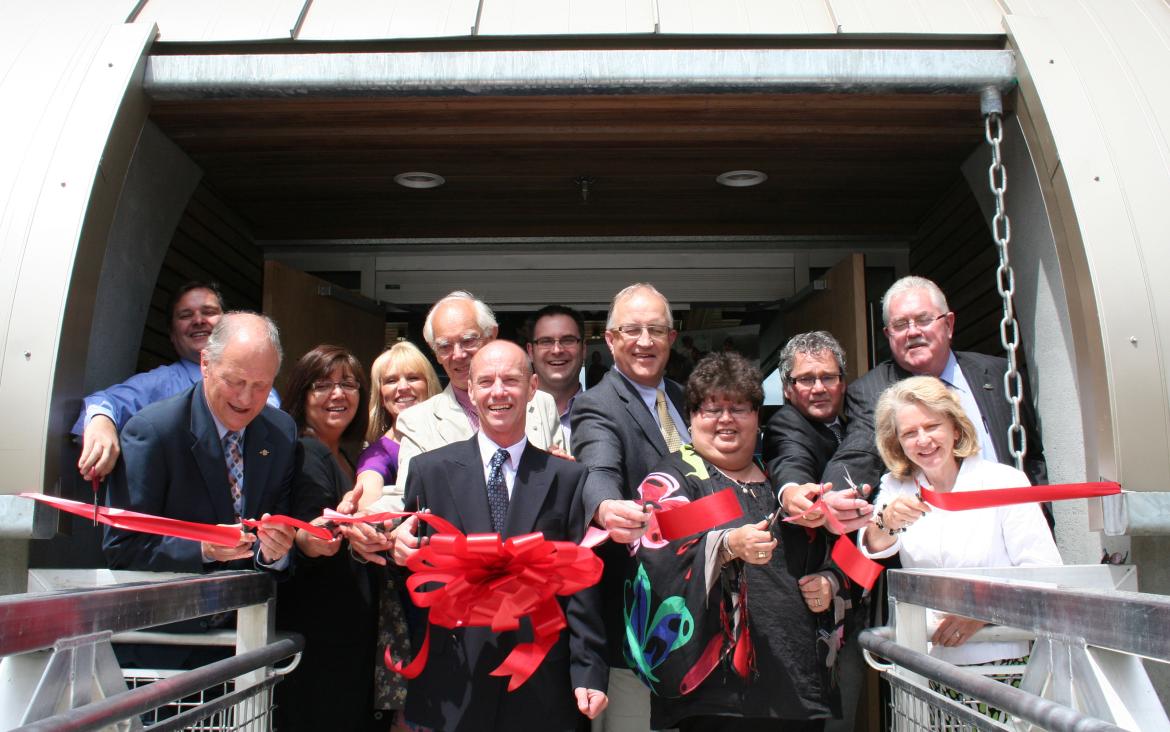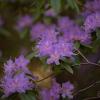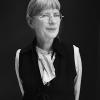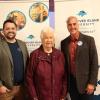
June 27, 2011 - 2:15am
There was added reason to celebrate at festivities on Thursday, June 23 to mark the grand opening of Vancouver Island University’s Deep Bay Marine Field Station.
The distinctive clamshell-shaped structure on the shores of Baynes Sound is being honoured with a 2011 National Green Buildings Award. The juried awards, offered through sister magazines Sustainable Architecture & Building (SABMag) and Sustainable Architecture & Building Homes (SAB Homes), recognize projects across Canada that demonstrate superior sustainable design, architectural excellence, and technical innovation.
“We are extremely proud of this honour,” says VIU President Ralph Nilson. “The Deep Bay Marine Field Station demonstrates how green building technology can work effectively from harvesting rainwater to extracting energy from the ocean through a geoexchange system.”
“Congratulations to all those who have contributed their talents and creativity to bring this project from concept to reality.”
Don Tillapaugh, Director of VIU’s Centre for Shellfish Research, says the field station was conceived and designed to connect people to the marine environment.
“The world needs marine protein; BC needs sustainable jobs in coastal communities. We have provided an architecturally inspiring place for discussion on how we achieve both while protecting the ocean we all value,” says Tillapaugh.
Field Station Manager Brian Kingzett says the setting of new facility provides abundant opportunities to provide real-life experiential learning opportunities, support research and engage with First Nations and other communities.
“We’re at the south end of Baynes Sound, the area of British Columbia where half of all the farmed shellfish are grown. This area is very important ecologically, environmentally and socially,” Kingzett says.
VIU’s Culinary Institute of Vancouver Island is making use of the teaching kitchen at the field station to develop students’ skills in preparing seafood and other local foods. There will also be opportunities for cooking classes open to the public.
Deep Bay Marine Field Station has already hosted high-profile national and international events.
Prime Minister Stephen Harper toured the facility as it entered the final stages of construction in September 2010. In January, international seafood experts from the SeaWeb Seafood Choices 2011 Seafood Summit in Vancouver were treated to a feast of sustainably produced seafood and other West Coast fare prepared by award-winning chefs and culinary students.
“Partnerships with communities, the food service sector, all levels of government and research agencies are key to the success of the field station,” says Tillapaugh.
The field station was designed and constructed to achieve a Leadership in Energy and Environmental Design (LEED®) Platinum rating. It represents the highest standard in the internationally recognized certification program, administered in this country by the Canada Green Building Council.
According to the National Green Building Awards jury, “The education and research centre’s beautiful shellfish-inspired form marries the inner and outer shell in a dynamic section. The building is designed to achieve LEED Platinum using readily available technologies, and delivers an impressive energy performance that is 65 per cent superior to a base building of the Model National Energy Code.”
Kingzett expressed appreciation to contractors in the mid-Vancouver Island region and beyond who met the challenge of the rigorous construction standards for the state-of-the-art facility.
“Our local trades really put their heart and soul into making this special building what it is,” Kingzett says.
Architect Larry McFarland said the inspiration for the clamshell shape of the facility evolved naturally.
“The concept for the shape came from a lot of people’s input and the setting of the field station,” says McFarland. “I’ve been diving since 1971 so I’ve seen a lot of shellfish in their natural habitat. I’ve learned to appreciate their vulnerability and their role in the marine ecosystem.”
McFarland says one of the biggest challenges in designing the facility was working with a site that did not have ready to access to services such as power, water and sewer.
“Designing a building is relatively simple,” says McFarland. “Making it work in what is essentially a wilderness setting is the challenge. We had to think of how to build a facility that is focused on research and teaching about aquaculture in a waterfront location and make it work without polluting the environment we’re trying to preserve.”
The 1,200 square metre (13,000 square foot) structure sits on a three-hectare waterfront site in the scenic coastal community of Deep Bay between Qualicum Beach and Courtenay, known locally as Lighthouse Country.
The theme of sustainability extends throughout the site. The building is made with a high-proportion of recycled materials, renewable resources such as wood and local materials. Solid wood floor panels have been produced from trees harvested in pine beetle-ravaged forests.
Construction wood waste was diverted from landfill by grinding it to mix as organics into topsoil. The topsoil is being used for native and drought-resistant plants specified by a site plan by Nanaimo landscape architect Victoria Drakeford.
Instead of paving, the roadways and parking areas are covered with crushed oyster shells, a permeable surface that reduces rainwater runoff.
Deep Bay Marine Field Station has been the venue for several community gatherings, educational tours and special events. In May, the field station hosted its first wedding.
On June 25, the field station will host one of the events in the Regional District of Nanaimo’s 2011 Green Buildings and Workshops series. For details, visit: www.rdn.bc.ca
Deep Bay Marine Field Station Facts
Project cost: $10.8 million
Estimated primary and secondary annual economic value of the shellfish industry in Baynes Sound: $20 million (including associated jobs)
Funding partners:
• Canada Foundation for Innovation
• BC Knowledge Development Fund
• Island Coastal Economic Trust
• Knowledge Infrastructure Program
• Community Futures WestCCAP
• Vancouver Island University
Sustainability strategies (from McFarland Marceau Architects Ltd.):
• ocean source geoexchange energy source
• radiant floor heating with displacement air ventilation
• natural ventilation
• natural lighting with high efficiency glazing
• daylighting controls & occupancy sensors in all rooms
• rainwater harvesting with gravity flow for toilets and fire protection
• indigenous landscaping and plantings
• on-site tertiary wastewater treatment
• riparian zone protection and rehabilitation
• sequestration/substitution effect of wood use on carbon release - 300 tonnes of carbon
Websites:
VIU Centre for Shellfish Research: viu.ca/csr
Deep Bay Marine Field Station: viu/deepbay
Deep Bay Marine Field Station photos: http://www.flickr.com/photos/viucsr/sets/72157624675267252/
VIU Office of Development and Alumni (for donations): viu.ca/giving
Sustainable Architecture & Buildings magazine: www.sabmagazine.com/winners-2011.html
McFarland Marceau Architects: mmal.ca
Tags: In the Community






